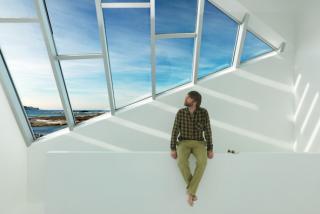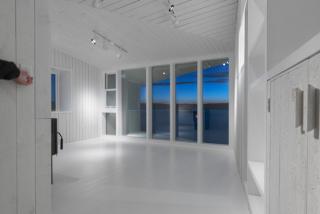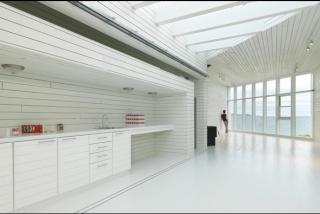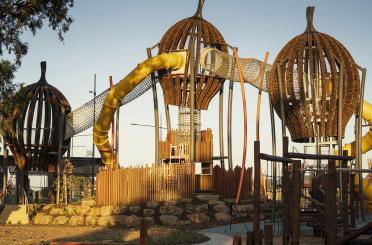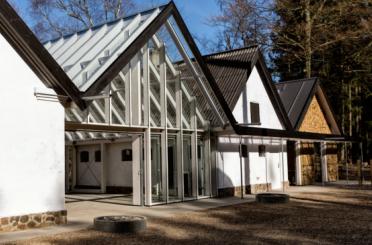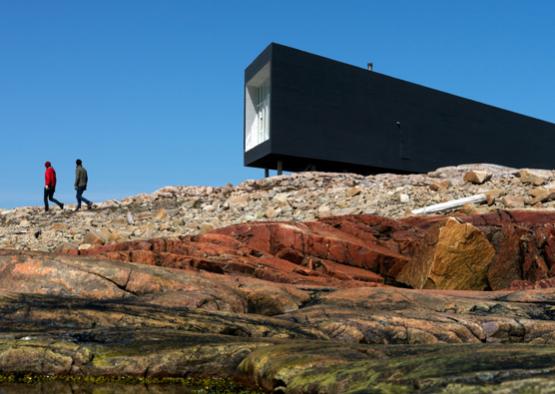
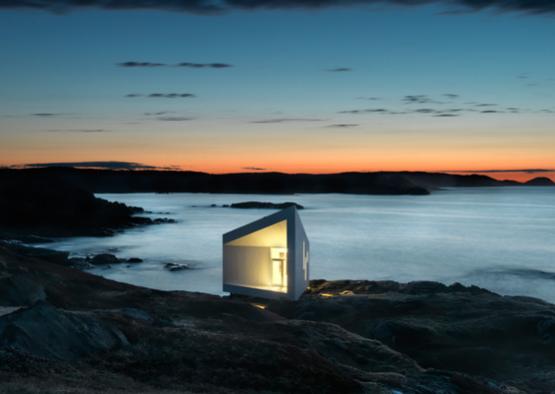
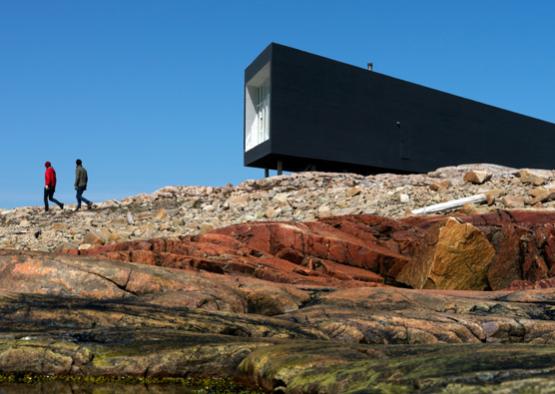
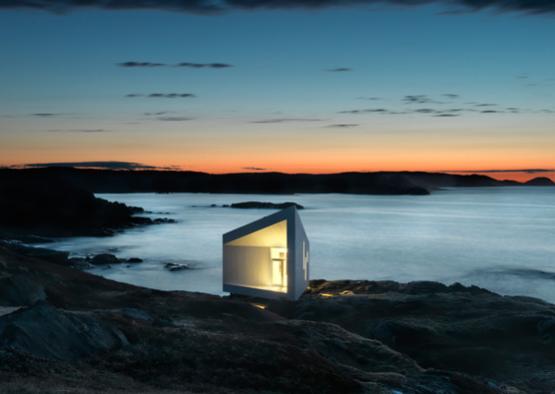
Overview
At its most dramatic, Fogo (Portuguese for fire) Island appears as a barren, wild and windswept landscape of stark boulders sitting on extensive outcrops of granite bedrock above a thin layer of soil and lichens.
It is a raw, stunningly beautiful place, and the setting for a special sociological and economic experiment in which architecture – as a vital component within the cultural fabric and the identity of a place – plays a central role.
In recent decades, the Fogo residents (2500) have seen their 300-year-old traditional way of life challenged following the decimation of the cod fishery. Enter Zita Cobb, a Fogo native who accumulated a fortune in the fibre optics business. She and brother Tony created the Shorefast Foundation – a social entrepreneurship model to stimulate the local economy.
Shorefast’s keystone project is an annual artists-in-residence program for more than 40 international film-makers, writers, artists and curators – all eventually working from six geometrically bold studio structures, each one contrasting starkly with its surroundings.
For this case study we profile four (Long, Bridge, Squish and Tower) of the six studio buildings created by Bergen-based Saunders Architecture.
Story and pictures by special arrangement with timber+DESIGN Magazine.
Additional information by WoodSolutions
Structure
The boldly geometric Fogo studios ranging in size from 20m2 to 200m2 are positioned all around the island, allowing visiting artists to live within the various communities and interact with residents.
The proportions of each studio are linear – projecting their occupant towards the Atlantic Ocean via a slanted, full-height window that frames the horizon or the shoreline, depending on where you are within the building.
The architects say the intent is to “sample and allude to” local construction techniques: the spruce wood shell cites the clapboard of the ‘outports’, or local fishermen’s houses; the stilt construction of Newfoundland’s waterfront fishing sheds; and the proportions of the volumes and skewed frames, particularly in the case of the smaller studios.
Painted and stained spruce (all exterior and interior cladding) and cedar (roof system) dominate a strong timber palette across the entire job.
The studios are not connected to the municipal water supply, sewerage, natural gas, electrical power grid or similar utility services. The environmental impact of the construction was reduced by the use of local materials, which were largely transported to remote building sites by hand.
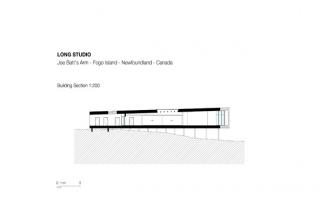
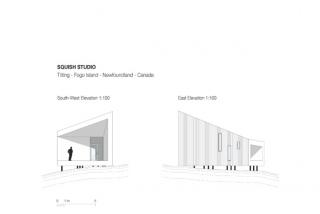
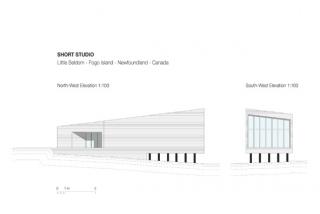
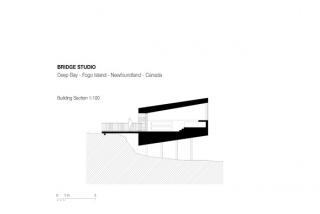
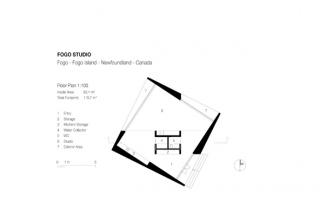
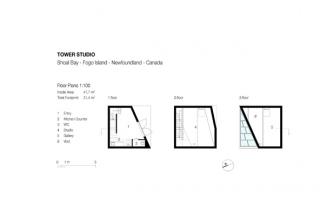
Exterior
Timber is a constant for the studios, with rough sawn spruce cladding a major feature, complemented by a cedar roof system.
Squish studio
The compact, trapezium-shaped Squish plan is augmented by a sheltered triangulated south entry deck and a north terrace that overlooks the ocean. The low (squished) front helps deflect winds from the stormy North Atlantic.
The downward-angled roof leads the eye to a full-height oblong glass window.
Bridge studio
The first impression of the Bridge studio is its abstract nature. From the side elevation it appears as a windowless, wood-clad parallelogram propped up by four piers and connected by a 5 m bridge to the adjacent hillside. In fact, the 30-m2 studio has a generous glass entry and a large, square window at the other end of the room.
Long studio
The 120 m2 Long studio has three spaces organised in a linear form. An ‘open but covered’ area marks the entrance and represents spring – the beginning of seasonal activity.
Tower studio
The Tower studio is a sculptural silhouette, leaning forward and back as it twists skyward.
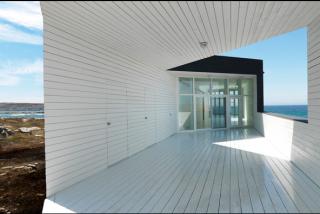
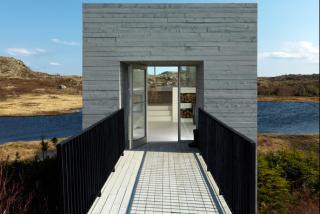
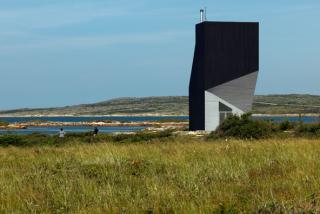
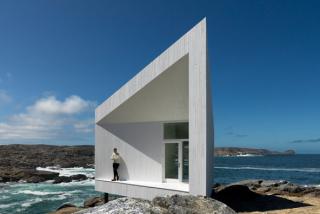
Interior
Squish studio
Vertical white-painted spruce planks inside are interrupted by a playful series of narrow windows integrated with an expanse of built-in cabinetry. The black slow combustion stove contrasts with the white on white interior.
Bridge Studio
From the glass entry, the ceiling slopes up to the top of the dominating window at the far end of the space. The built in desk is level with the window sill, providing the occupant with a seamless sense of transition to the exterior terrain.
The lower entry and kitchen areas are separated from the upper area by several steps creating a functional break.
Long studio
Inside, the Long studio is an elongated space, accented by the lines of the white painted pine planks and white kitchenette and work area.
Exposed timber framing houses a triangular skylight, the light from which is complemented by a large glass window that terminates the structure, exposing the occupants to sights of the weather beyond.
Tower studio
The three levels Tower Studio rise thirty-two feet above the surrounding landscape. The first level comprises an entry area with a kitchenette, a compost toilet and slow combustion heater, the second level a skylight lit studio, a ladder from the overhead mezzanine leads to a roof deck.
